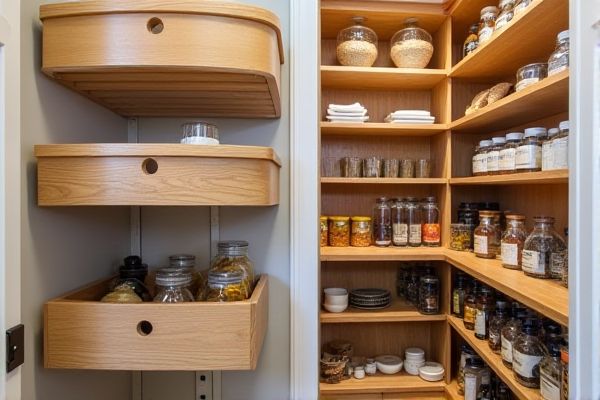
Adjustable bin systems in your pantry offer customizable storage options that adapt to varying item sizes, maximizing space efficiency compared to fixed bin systems with predetermined compartments. Discover which pantry bin system suits your organization needs best by reading the rest of the article.
Table of Comparison
| Feature | Adjustable Bin System | Fixed Bin System |
|---|---|---|
| Flexibility | High - Bins can be resized/reconfigured to fit different items | Low - Bins have preset sizes and locations |
| Space Optimization | Maximizes use of available pantry space | Limited by fixed dimensions |
| Installation | Requires adjustable hardware/components | Simple, fixed installation |
| Cost | Higher initial investment | More affordable upfront |
| Maintenance | Easy to update and reorganize | Less flexible, requires replacement for changes |
| Ideal For | Dynamic kitchen needs, varied storage items | Consistent storage needs with uniform items |
Introduction to Pantry Organization Systems
Adjustable bin systems offer versatile storage options in your pantry by allowing customization based on the size and quantity of items, maximizing space efficiency. Fixed bin systems provide a stable, uniform layout ideal for consistent storage needs but may limit flexibility when rearranging pantry contents. Choosing between adjustable and fixed bins depends on your specific pantry organization goals and the types of items you regularly store.
What is an Adjustable Bin System?
An adjustable bin system in a pantry consists of bins or containers that can be repositioned or resized to fit varying storage needs, offering flexibility. Unlike fixed bin systems, adjustable bins allow You to customize the arrangement for different food products, maximizing space efficiency and accessibility. This adaptability makes it ideal for accommodating changing pantry items and reducing clutter effectively.
What is a Fixed Bin System?
A fixed bin system in a pantry consists of stationary storage bins that are permanently attached or built into shelving units, offering consistent organization without the need for reconfiguration. This system maximizes stability and is ideal for storing items with uniform sizes, but lacks flexibility for accommodating varying container dimensions. Fixed bins provide clear, designated spaces that simplify inventory management yet limit customization compared to adjustable alternatives.
Key Differences Between Adjustable and Fixed Bin Systems
Adjustable bin systems offer customizable storage options with bins that can be repositioned to accommodate varying pantry item sizes, enhancing flexibility and space utilization. Fixed bin systems feature predetermined compartments, providing a stable and organized layout but limiting adaptability to changing storage needs. Key differences center on flexibility, customization, and ability to optimize space for diverse pantry contents.
Space Optimization: Adjustable vs Fixed Bins
Adjustable bin systems maximize pantry space optimization by allowing customization of bin sizes to fit varying items, reducing wasted space and enhancing organization. Fixed bin systems limit flexibility, often resulting in unused or inefficiently used areas due to set dimensions that cannot adapt to different storage needs. The versatility of adjustable bins supports better space utilization, making them ideal for dynamic pantry contents.
Flexibility and Customization
Adjustable bin systems in pantries offer superior flexibility and customization by allowing shelves and compartments to be repositioned or resized to accommodate varying container sizes and types. Fixed bin systems provide limited adaptability, as their predetermined dimensions restrict storage options and make it challenging to optimize space for diverse pantry items. Users seeking tailored organization and efficient space utilization benefit more from adjustable bin systems, which adapt to evolving storage needs over time.
Installation and Maintenance Comparison
Adjustable bin systems offer straightforward installation with modular components that easily snap or slide into place, requiring minimal tools or expertise compared to fixed bin systems, which often demand precise measurement and mounting hardware. Maintenance is simpler for adjustable bins as they can be removed individually for cleaning or reconfiguration, whereas fixed bins typically require disassembly or more effort to access and maintain. Your choice affects long-term convenience, with adjustable systems providing greater flexibility for evolving storage needs and easier upkeep.
Cost Considerations
Adjustable bin systems generally incur higher initial costs due to their flexible design and customizable components, while fixed bin systems offer a more budget-friendly option with standardized sizes and simpler installation. Over time, adjustable bins may provide cost savings by reducing the need for replacement or additional storage solutions as pantry needs evolve. Fixed bin systems can lead to increased expenses if modifications or expansions are required to accommodate changing organization demands.
Best Use Cases for Each System
Adjustable bin systems offer optimal flexibility for organizing a pantry with varying item sizes, making them ideal for households that frequently change their storage needs or stock diverse products. Fixed bin systems provide a stable, cost-effective solution for storing uniform items, such as canned goods or boxed foods, ensuring easy access and consistent organization. Your choice depends on whether you prioritize customization and adaptability or straightforward, reliable storage.
Which Pantry Bin System is Right for You?
Adjustable bin systems offer versatile storage tailored to varying pantry sizes and item dimensions, enhancing accessibility and maximizing space efficiency. Fixed bin systems provide consistent, uniform compartments ideal for those seeking simplicity and predictability in organizing pantry essentials. Choosing the right pantry bin system depends on your storage needs, space flexibility, and preference for customization versus standardized organization.
 homyna.com
homyna.com